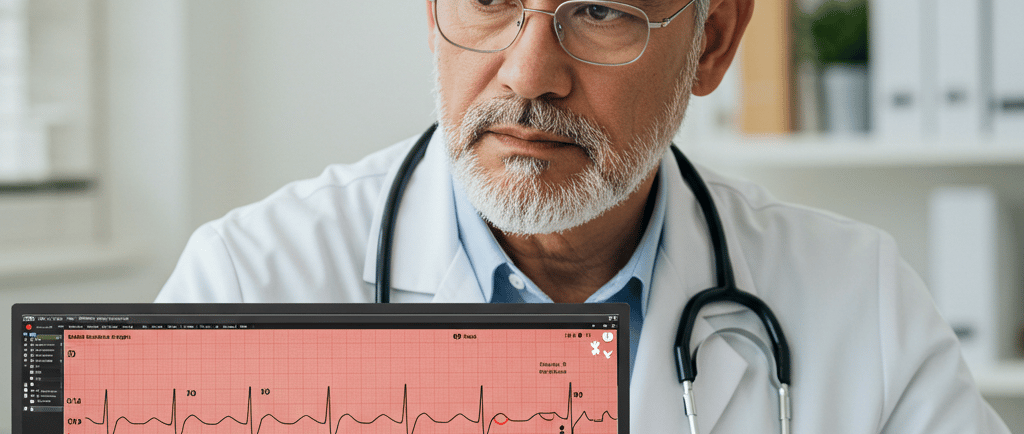How Clinicians Use BodyKom to Detect Early Warning Signs of Cardiac Events
In cardiovascular medicine, time is often the most critical variable. The early identification of arrhythmias, ischemic episodes, and other abnormal heart rhythms can mean the difference between manageable treatment and a life-threatening emergency. BodyKom, a mobile cardiac monitoring solution, offers clinicians a powerful tool to detect early warning signs of cardiac events—while patients go about their daily lives.
4/5/20252 min read


Real-Time ECG Data for Early Intervention
BodyKom provides continuous, real-time electrocardiogram (ECG) monitoring via a wearable device that communicates wirelessly through mobile networks. This enables clinicians to detect transient or intermittent events that traditional Holter monitors may miss due to their limited data capture windows (Hindricks et al., 2021).
Clinicians receive ECG data through a centralized backend system that not only streams live readings but also allows threshold customization for each patient. When the system detects deviations—such as sudden bradycardia, tachycardia, or irregular rhythms—it can automatically generate alerts to the clinician, facilitating immediate evaluation and clinical response (Sörnmo & Laguna, 2005).
Use Case 1: Detection of Paroxysmal Atrial Fibrillation (PAF)
A 64-year-old male with hypertension and diabetes presented with occasional palpitations. Traditional in-clinic ECGs and a 24-hour Holter monitor failed to capture any abnormalities. Using BodyKom, the patient was monitored for seven days while maintaining normal activities. On Day 4, a two-hour episode of paroxysmal atrial fibrillation (AF) was detected, triggering an automatic alert to the cardiology team.
Immediate anticoagulation therapy was initiated, and follow-up echocardiography revealed no thrombus formation. Early detection prevented potential thromboembolic complications, demonstrating the value of mobile ECG in identifying otherwise elusive arrhythmias (Camm et al., 2020).
Use Case 2: Silent Ischemia in a Post-PCI Patient
A 58-year-old female, one month post-percutaneous coronary intervention (PCI), was enrolled in remote monitoring with BodyKom due to complaints of fatigue. While asymptomatic, BodyKom data flagged ST-segment depressions during evening hours over consecutive days.
The care team adjusted her medication and scheduled an urgent perfusion scan, revealing stress-induced ischemia. Her stent was successfully revised before a major cardiac event occurred. Without BodyKom’s continuous surveillance, the ischemic changes may have remained undetected until symptomatic deterioration.
Use Case 3: Bradycardia in an Elderly Patient on Beta Blockers
An 81-year-old female with a history of atrial fibrillation and heart failure with reduced ejection fraction was placed on beta blockers. During titration, BodyKom monitoring revealed episodes of symptomatic bradycardia (heart rate <40 bpm) correlated with dizziness and near-syncope.
The clinician was able to adjust the medication remotely, avoiding an ER visit or hospitalization. The integration of symptom data and ECG readings helped guide a safer, more personalized therapy regimen (Kotecha et al., 2017).
Clinical Utility and Workflow Integration
Clinicians benefit from BodyKom's ability to:
Customize patient-specific thresholds for arrhythmia and rate changes
Monitor ECG changes continuously across real-world environments
Receive automated alerts for review and triage
Document and download reports directly into electronic health records (EHRs)
The system supports early detection, risk stratification, and optimized medication management. By shifting from episodic to continuous monitoring, BodyKom bridges a critical gap in ambulatory cardiac care.
Conclusion
Mobile cardiac monitoring platforms like BodyKom empower clinicians to identify early signs of cardiac deterioration that would otherwise go unnoticed. Through real-time ECG transmission, automated alerts, and backend analytics, clinicians can act before conditions worsen—offering better outcomes for patients and more efficient use of healthcare resources.
As the healthcare landscape moves toward proactive and patient-centric care models, tools like BodyKom will play an essential role in transforming cardiac diagnostics and decision-making.
References
Camm, A. J., Lip, G. Y. H., De Caterina, R., et al. (2020). "2019 AHA/ACC/HRS Focused Update on Atrial Fibrillation." Circulation, 141(2), e125–e151.
Hindricks, G., Potpara, T., Dagres, N., et al. (2021). "2020 ESC Guidelines for the diagnosis and management of atrial fibrillation." European Heart Journal, 42(5), 373–498.
Kotecha, D., Holmes, J., Krum, H., et al. (2017). "Efficacy of beta blockers in patients with heart failure and reduced ejection fraction: Individual patient data meta-analysis." BMJ, 356.
Sörnmo, L., & Laguna, P. (2005). Bioelectrical Signal Processing in Cardiac and Neurological Applications. Elsevier.
